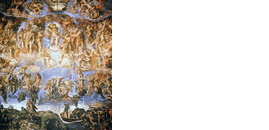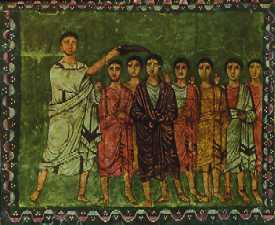
|
|
|
|
|
Class
Prep
|
|
|
|
- 1
Enoch: The Book of the Watchers & the Apocalypse of Weeks
-

- We begin our study of technology, spectacle and the apocalyptic
crisis with one of the earliest Jewish apocalypses to have survived
from antiquity, 1 Enoch. The "book" is actually a composite work -- its several originally separate sections were eventually merged into one work because they all shared the same protagonist, Enoch. The separate pieces are:
-
- The Book of the Watchers
(1 En 1-36)
-
- The Similitudes
(1 En 37-71)
-
- The Astronomical Book (1 En 72-82)
-
- The Book of Dream Visions (1 En 83-90)
-
- The Epistle of Enoch (1 En 91-107, which includes the
Apocalypse of Weeks in 93:1-10 + 91:11-17)
-
- Our focus today is on just the first and last of these sections.
-
- Before you launch into these apocalyptic works, scan the first chapters of the Bible, Genesis 1-12. There you will find Enoch mentioned a few times (4:17-18; 5:18-24; cf. Luke 3:37; Hebrews 11:5-6; Jude 14-16). Pay particular attention to the short story in Genesis 6:1-4; it is the foundation on which the Book of the Watchers is built. Note also the story of the flood, the first catastrophic destruction and rebirth of the world on which later apocalyptic visions would be based.
-
- Now read the selections from the Enoch books compiled in Reddish
(on ERes). These two pieces of the Enoch tradition
were chosen because they exemplify the two different styles of
apocalyptic writing that Collins discussed in his first chapter:
the otherworldly journey (Book of the Watchers) and the historical
apocalypse (Apocalypse of Weeks). As you read, take
notes on the following questions:
-
-
- In what ways is the story of the Watchers expanded from
the story of the "sons of God" in Genesis 6:1-4?
- In what respects is the Book of the Watchers an apocalyptic
"spectacle"? What role does technology
play in the story?
- How is evil introduced in these two works, and how is it destroyed?
-
- The secondary readings -- that is, Reddish's introductions,
the Collins chapter on Enoch, and the Wallace article on ERes
-- will help us to address the discourse level of the Enoch material. Once we've determined what's going on in the story, we want to ask what's going on in the author's time that led him/them to compose these pieces. Wallace's essay is a complex piece of sociological analysis that aims to analyze how groups respond to crisis. Make a list of the six responses Wallace presents. Then, as you read the Reddish and Collins material, discern what historical crises generated the Enoch books and suggest which of Wallace's responses to crisis best fits the material.
-
-
- Assigned Readings
- Primary: Genesis 1-11 (NRSV); Reddish 143-62,
54-7 (ERes)
- Secondary: Reddish 19-38; Collins 43-59, 62-7, 70-79;
Wallace, "Revitalization Movements" (ERes)
- Optional: Reddish, 163-6 (Commentary on the Similitudes
of Enoch, ERes)
-
-
- Further Reading
 Nickelsburg, George W. E. 1 Enoch: A Commentary
on the Book of 1 Enoch Chapters 1-36, 81-108, Hermeneia Commentary
Series. Minneapolis: Fortress, 2001.
Nickelsburg, George W. E. 1 Enoch: A Commentary
on the Book of 1 Enoch Chapters 1-36, 81-108, Hermeneia Commentary
Series. Minneapolis: Fortress, 2001.
-
- --------. "The Apocalyptic Construction
of Reality in 1 Enoch." In Mysteries
and Revelations: Apocalyptic Studies since the Uppsala
Colloquium (ed. John J. Collins and James H. Charlesworth;
JSPSup 9; Sheffield: Sheffield Academic Press, 1991) 51-64.
-
 VanderKam, James C. Enoch and the Growth of an
Apocalyptic Tradition, Catholic Biblical Quarterly Monography
Series 16. Washington, D. C.: Catholic Biblical Association,
1984.
VanderKam, James C. Enoch and the Growth of an
Apocalyptic Tradition, Catholic Biblical Quarterly Monography
Series 16. Washington, D. C.: Catholic Biblical Association,
1984.
-
- See also the section of the Course Bibliography on the Enoch
Literature.
-
-
- Links
-
-
-
- Sources
- Photograph:
|
|
|
|
|
